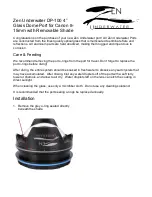
Deep SUNA Manual
For SUNA running firmware version 2.4 or later
3. The SUNA Sensor
5.4 Data Processing Configuration). In oceanographic or estuarine settings, data must
be processed for seawater, in freshwater settings data processing is ideally selected to
be for freshwater. In seawater settings, the sensor precision can be brought into the
freshwater precision by using Temperature-Salinity-Correction (see section 5.4.2
Special Case: Temperature-Salinity Correction).
Table 8: Precision specification for nitrate concentrations
Processing configuration
Freshwater or Seawater
with T-S-Correction
Seawater
[0–40 psu]
Short-term precision [at 3σ]
0.3 μM
2.4 μM
Drift [per hour of lamp time]
<0.3 μM
<1.0 μM
The limit of detection is defined as the nitrate concentration that has a value of 3 times
the standard deviation of the blank nitrate concentration. As such, it is 3 times the
standard deviation as measured for the sensor precision, which depends on the
processing mode.
The limit of quantification specifies the limit at which two samples can be reasonably
distinguished. Typically, it is 10 times the standard deviation of the blank nitrate
concentration.
Table 9: Limit of Detection and Limit of Quantification
Processing configuration
Freshwater or Seawater
with T-S-Correction
Seawater
[0–40 psu]
Limit of detection [LOD]
0.3 μM
2.4 μM
Limit of quantification [LOQ]
1.0 μM
8.0 μM
Natural waters may contain a mixture of interfering species that are typically hard to
delineate. The impact of interfering species on the measured nitrate concentration was
determined under laboratory conditions. The specification covers two classes of
interfering species: suspended particulate matter (Turbidity) and colored dissolved
organic matter (CDOM). The impact is independent of the optical path length, from
theoretical considerations as well as experimentally confirmed. However, the SUNA can
only operate up to absorbances of approximately 1.5. This limit is typically reached at
625 NTU (Nephelometric Turbidity Units) for 10 mm path length, or at 1250 NTU for 5
mm path length. Naturally occurring CDOM concentrations stay within the operating
range of the SUNA.
The following substances were uses as proxies for turbidity:
ARD Arizona Road Dust
Kaolin Kaolin Powder
Copyright © 2013, Satlantic LP, All rights reserved
14














































